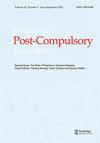大学级通用学习设计分析:最大限度提高学习成果、包容性和公平性的有效方法
IF 0.9
Q3 EDUCATION & EDUCATIONAL RESEARCH
引用次数: 0
摘要
通用学习设计(UDL)被认为是为所有有或没有残疾的学习者提供公平的机会。本研究旨在调查大学水平的ESL课堂实施UDL的程度。采用混合方法,探索在UDL原则方面最大限度地提高学习成果、包容性和公平性的有效方法;学生和老师的声音都得到了回应。通过对学生的在线问卷调查和对教师的半结构化访谈来探讨UDL在课堂上的应用。调查结果显示,教师在课堂上不同程度地采用了UDL原则。他们还探讨了提高参与、代表、行动和表达水平的各种策略。然而,在这个过程中,他们经历了不同的紧张关系。该研究的结论对研究人员、教师和政策制定者在建立一个更加包容和公平的学习环境方面具有启示意义。本文章由计算机程序翻译,如有差异,请以英文原文为准。
An analysis of Universal Design for Learning at collegial level: effective ways to maximise learning outcomes, inclusion, and equity
ABSTRACT Universal Design for Learning (UDL) is considered to provide equitable opportunities for all learners with or without disabilities. This study aimed to examine the extent to which UDL was implemented in ESL classrooms at the university level. A mixed-method approach was conducted to explore the effective ways to maximise learning outcomes, inclusion, and equity regarding UDL principles; both students’ and teachers’ voices were addressed. Online questionnaires for students and semi-structured interviews for teachers were used to probe the UDL application in the classrooms. The findings revealed that teachers employed UDL principles in their classrooms to varying degrees. They also explored various strategies to enhance levels of engagement, representation, action, and expression. However, they experienced different tensions during the process. The study concluded with implications for researchers, teachers, and policymakers in developing a more inclusive and equitable learning environment.
求助全文
通过发布文献求助,成功后即可免费获取论文全文。
去求助
来源期刊

Research in Post-Compulsory Education
EDUCATION & EDUCATIONAL RESEARCH-
CiteScore
1.30
自引率
14.30%
发文量
31
期刊介绍:
Throughout the world, there is a growing awareness of the significance of vocational and post-compulsory education and training systems. The majority of countries are working hard to develop their provision, recognising the importance of post-compulsory education in providing educated and skilled people in sufficient numbers at appropriate levels to assist economic and social development. Research in Post-Compulsory Education, sponsored by the United Kingdom"s Further Education Research Association (FERA), recognises the need for more international research and analysis and the generation of relevant theory in order to identify policy needs and trends as well as priorities in this growing area.
 求助内容:
求助内容: 应助结果提醒方式:
应助结果提醒方式:


